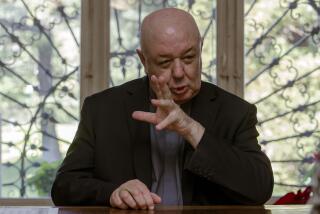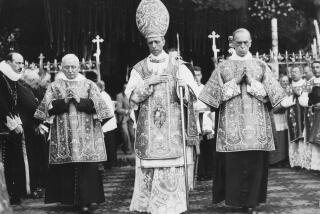Daughter’s Love, Faith in Galileo Revealed in Letters to Him
- Share via
In 1600, the year Galileo’s first daughter was born, the Italian philosopher Giordano Bruno was burned at the stake for heresy, having suggested, among much else, that the universe was infinite and that the Earth traveled around the sun. More than half a century earlier, Polish mathematician and astronomer Nicolaus Copernicus had reached the conclusion that the Earth and other planets revolved around the sun. But Copernicus did not publish his findings until 1543, when he was 70 and on his deathbed. When Italian scientist Galileo Galilei (1564-1642) found himself coming to the same conclusions, it was not long before he was summoned to Rome to answer Inquisitorial questions. Although it could be said he got off relatively lightly, he was tortured, forced to retract his views and confined to house arrest for the rest of his days.
Looking back on the conflicts between these pioneers of modern science and the Roman Catholic Church, we tend to see them as conflicts between science and religion, rationalism and faith. One of the central themes of Dava Sobel’s prize-winning history “Galileo’s Daughter” was that Galileo was a sincere Catholic who did not consider his scientific discoveries to be irreligious.
Certainly, in the letters written to him by his older daughter, a devout nun, there is no sense of a conflict between faith and science, only shared love and shared values. Although Galileo’s side of the correspondence seems to have been destroyed, 124 letters written by his daughter have survived. Sobel included 21 of them in “Galileo’s Daughter” and has now given us the complete set. “Letters to Father: Suor Maria Celeste to Galileo, 1623-1633” is a finely produced book with Sobel’s English renditions on facing pages to the texts in the original Italian. It’s clearly a labor of love, with proceeds from its sales going to help Suor Maria Celeste’s order, the Poor Clares.
Maria Celeste was born “Virginia,” the first of three out-of-wedlock children that Galileo had with a woman of a lower social class, who later married someone else. Galileo managed to legitimize the third child, a boy. But Virginia and her younger sister Livia, like many Italian girls whose marital prospects were not good, were placed in a convent. (The stigma of illegitimacy and lack of substantial dowries gave them little chance of finding suitable husbands.) Livia, who took the name “Suor Arcangela,” remains a silent, shadowy figure, known to us mainly through the words of her older sister.
Articulate and thoughtful, Suor Maria Celeste was a devoted daughter, a good sister and a valued member of her order, where she often served as its apothecary. In the years these letters were written, Europe was embroiled in religious wars and ravaged by outbreaks of bubonic plague. Maria Celeste only glancingly touches upon the former but is much concerned with the latter and indeed with all the many ailments and diseases that threaten the lives of those she loves. She constantly advises her father to look after his health, often sends him pills she has made and just as often asks him to send special food or herbal ingredients to make medicines for other members of her order.
Indeed, perhaps the most powerful impression that one gets from her accounts of daily existence is simply how very difficult life was back then. Food was scarce, clothing expensive, illness common and money hard to earn. And life was even more straitened in the convent, where nuns like Maria Celeste often had to ask their families for financial help to buy supplies and pay the rent on their cells. “I had wanted to make you some rosemary flower jam, Sire, but I am waiting for you to return one of my glass jars, because I have nothing to hold the jam...” she explains.
Galileo was clearly a devoted father who did his best to fulfill all her requests. Despite the formality of the style in which she addresses her “Most Illustrious Lord Father,” there’s no mistaking the trust and closeness in the relationship. “So as not to transgress against your commandment for a full account of our health,” she writes, “I tell you that I am following the doctor’s orders by not observing Lent, and that, being already mostly toothless at my age, I will be very pleased if you can send me some fatty mutton, for surely I can manage to eat that.” She was only 27 when she wrote this. Six years later, she died.
The reader will feel the shock of her loss, for Maria Celeste’s quick intelligence and steadfast courage are as evident as her piety and modesty. She had no doubt of her father’s innocence. Nor did she detect anything heretical in his scientific findings. The disposition of his case was a shock to her: “so intensely did it pierce my soul with pain to hear the judgment that has finally been passed, denouncing your person as well as your book.” She felt certain he would be vindicated as, in the long run, more than 31/2 centuries later, he was.
More to Read
Sign up for Essential California
The most important California stories and recommendations in your inbox every morning.
You may occasionally receive promotional content from the Los Angeles Times.










